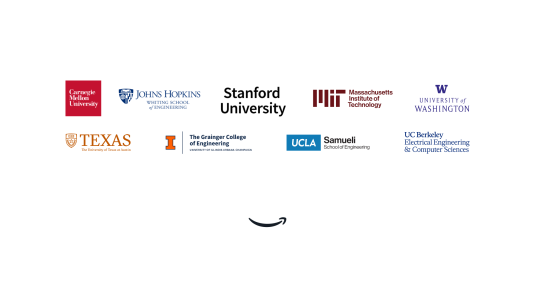Danielle Maddix Robinson had been working at Amazon Web Services (AWS) for about a year and a half when the COVID-19 pandemic presented a type of forecasting challenge quite different from the ones she had been handling in her job as an applied scientist.
The key question: Based on the number of cases so far, how many infections, recoveries, and deaths could be expected to occur in the future?
Amazon had long used computer models to forecast retail demand — when customers will want a particular product and how much of it. Maddix Robinson wanted to see whether those same algorithms could be applied to the public health crisis. The answer: not quite.
Better COVID predictions
The deep learning techniques that had worked successfully for Amazon's business benefited from a large amount of data. But early on in the pandemic, the data to make predictions was lacking.
"Out of the box, we found that these deep learning models were not performing as well as we would have hoped," Maddix Robinson says.
At the same time, the physics-based models typically used to forecast epidemics were not working perfectly, either. These approaches employ ordinary differential equations (ODEs) to compute different stages, or "compartments," along the disease trajectory, from susceptibility to exposure to infection. Compartment models tend to do better at predicting infection and recovery, while deep learning models more accurately predict deaths.
Maddix Robinson and colleagues at Amazon and the University of California, San Diego, proposed a third way: combining ODEs and machine learning. The hybrid approach, it turned out, improved on both machine learning and compartment models, achieving a 57.4% reduction in mean absolute errors on week-ahead predictions of COVID-19 trajectories, compared to other deep learning models.
The resulting paper, "AutoODE: Bridging Physics-based and Data-driven modeling for COVID-19 Forecasting," won a best paper award at the NeurIPS Machine Learning in Public Health Workshop in December 2020. Maddix Robinson’s Amazon co-authors were Yuyang (Bernie) Wang, a principal machine learning scientist and Christos Faloutsos, the Fredkin Professor of Artificial Intelligence at Carnegie Mellon University (CMU) and an Amazon Scholar; the paper’s other co-authors were Rui Wang and Rose Yu from the University of California, San Diego. Maddix Robinson worked directly with Rui Wang, mentoring him on the research that informed the paper while he was a summer intern on her team.
An early gift for math
Maddix Robinson, who was promoted to senior applied scientist in April 2021, generally focuses on time series forecasting as it applies to various needs for Amazon customers.
"One thing I really enjoy about this role is the emphasis on the core mathematical modeling, which was in my background," says Maddix Robinson, who joined Amazon after earning her PhD in computational and mathematical engineering from Stanford University, where she also earned her master's degree in the same field.
As an undergrad at the University of California, Berkeley, she was interested in both biochemistry and math, taking classes in both areas. "But once I took all the calculus courses and linear algebra, I really just fell in love with it," she says. "I just saw the beauty of math as a universal language." She graduated with a bachelor's in applied mathematics.
Growing up in Alameda, California, Maddix Robinson gravitated to math from an early age — she liked the feeling of solving puzzles. She had help and encouragement from her mother, Denise Cervelli Maddix, a mathematician who worked at Lawrence Livermore National Laboratory.
"Seeing a female role model when I was younger really made me want to pursue a career in math," she says.
Seeing a female role model when I was younger really made me want to pursue a career in math.
Her mother's math models were used in earth science research at Lawrence Livermore. "So as a kid, I was always interested in seeing how math could be used to address practical problems," Maddix Robinson says. That's something I really like about this role at Amazon. I feel like it fits that niche of what I was looking for."
Maddix Robinson said encouragement from her father, Daniel Maddix, a pharmacist and infectious disease expert who worked at the San Francisco VA Medical Center, motivated her to apply mathematics to epidemiology and public health. “I was excited to get that first opportunity with the COVID forecasting project at AWS AI Labs,” she says.
As a graduate student, Maddix Robinson sought positions in academia, industry, and national research labs to determine which was the best fit. She taught courses in advanced MATLAB and numerical linear algebra refresher courses, among other research and educational activities at Stanford. She worked as a computational researcher at Lawrence Berkeley National Lab and as an extreme-scale data analytics intern at Sandia National Laboratories. And she was a software engineer intern at NVIDIA, where she worked on linear algebra algorithms for the company's cuSPARSE library related to GPU processing.
"That was a very good programming experience for me, mixed with math," Maddix Robinson says of her time at NVIDIA. "That gave me a sense that I really did enjoy industry."
Seeking simplicity and efficiency
In the last year of her doctorate work, Maddix Robinson was evaluating different companies to work. She was intrigued by the work presented by various AWS AI scientists at the 2017 Machine Learning Conference (MLConf). Maddix Robinson was attracted to AWS AI’s mission and its approach: It was research-oriented, with the opportunity to publish papers, but fast-paced and focused on delivering products.
“Danielle is a quintessential all-round scientist whose work exemplifies customer-obsessed science,” said Bernie Wang, the principal machine learning scientist who leads Maddix Robinson’s team. “Not only does she have deep technical expertise in machine learning and applied math, what sets her apart is her strong sense of ownership, attention to details, excellent communication and organizational skills, her ability to build consensus and move complex projects forward, and her influence on the team through collaboration and mentorship.”
Solving some of the potentially daunting challenges in her team's work requires a willingness to take them on one step at a time. "An ambiguous problem is what research is, at its core," Maddix Robinson says. "So I would say don’t be put off by something that seems ambiguous at first. Break it up into core sub-problems."
She also appreciates that she also gets to mentor and teach graduate students through Amazon's summer internship program. "Our team is very collaborative and also interdisciplinary," she says. "Everyone's looking to help each other learn and grow. It's a very supportive environment that I found similar to academia, which I enjoy."
Teaching others has an important secondary benefit, Maddix Robinson notes. Thinking about how to clearly explain a concept helps her understand it more deeply.
"At the end of the day,” she says, “that's what we're looking for: not the most complex solution, but a simple and efficient solution."























